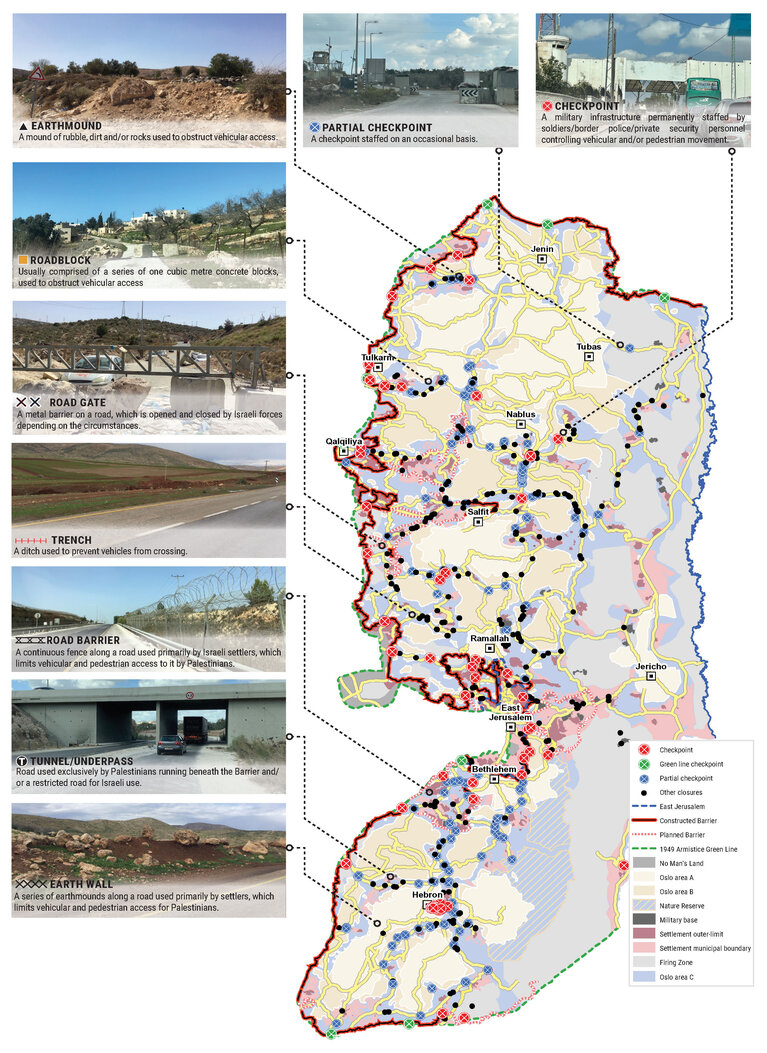תנועה וגישה בגדה המערבית | יולי 2023
עובדות
- בתחילת 2023 תיעד משרד האו״ם לתיאום עניינים הומניטריים 565 מכשולי תנועה בגדה המערבית, כולל ירושלים המזרחית אבל ללא H2 בחברון. אלה כוללים 49 מחסומים המאוישים באופן מתמיד על ידי כוחות ישראליים או חברות אבטחה פרטיות, 139 מחסומים המאוישים מעת לעת, 304 חסמי דרכים, תלוליות עפר ושערי דרך, ו־73 סוללות עפר, גידורי כביש ושוחות.
- בנוסף, 80 מכשולים, לרבות 28 מחסומים מאוישים תמידית, מפרידים את חלק העיר חברון שבשליטת ישראל (H2) מיתר חלקי העיר; מחסומים רבים מתוגברים בגלאי מתכות, מצלמות מעקב וטכנולוגיות זיהוי פנים, ובמתקני מעצר וחקירה.
- יחד, ישנם 645 מכשולים פיזיים – גידול של כ־8% לעומת 593 המכשולים שתועדו בסקר החסמים הקודם שערך משרד האו״ם לתיאום עניינים הומניטריים בינואר-פברואר 2020.
- באופן ספציפי, מספר המחסומים המאוישים מעת לעת גדל ב־35%, ומספר שערי הדרך גדל ב־8%. אמנם אלה פתוחים רוב הזמן, אבל הם יכולים להיסגר בכל עת. ב־1,032 הזדמנויות (או 293 ימים) בשנת 2022 אוישו בגדה המערבית מחסומים שאינם מחסומי קבע.
- להערכת משרד האו״ם לתיאום עניינים הומניטריים, ליותר ממחצית מהמכשולים (339 מתוך 645) נודעו השלכות קשות על פלסטינים משום שהם מונעים או מגבילים את הגישה והתנועה אל כבישים ראשיים, מרכזים עירוניים, שירותים ושטחים חקלאיים ובתוכם.
- כמו כן, בשנת 2022 פרשו כוחות ישראליים בממוצע מדי שבוע ארבעה מחסומי פתע בכבישי הגדה המערבית.
- בנוסף, גדר ההפרדה הישראלית, שאורכה 712 ק״מ (לרבות 65% שכבר נבנו) עוברת ברובה בתוך שטח הגדה המערבית. רוב החקלאים הפלסטינים שבבעלותם אדמה בשטח שבין גדר ההפרדה לקו הירוק יכולים להגיע למטעים שלהם דרך 69 שערים; אולם, רוב הזמן הרשויות הישראליות משאירות שערים אלה סגורים.
- פלסטינים בעלי תעודות זהות פלסטיניות, למעט גברים בני יותר מ־55 ונשים בנות יותר מ־50, זקוקים להיתרים מהרשויות הישראליות כדי להיכנס לירושלים המזרחית דרך שלושה מחסומים ייעודיים.
- בשנת 2022, 15% מבקשות ההיתרים שהגישו מטופלים פלסטינים שנזקקו לטיפול במתקני רפואה בירושלים המזרחית או בישראל ו־20% מבקשות ההיתרים עבור מלווים של מטופלים מהגדה המערבית לא אושרו עד למועד התור שנקבע להם. בשנה ההיא, 93% מההעברות של בני אדם באמבולנס לירושלים המזרחית עוכבו בשל נוהל "גב־אל־גב", שבמסגרתו – בשל ההגבלות שמטילות הרשויות הישראליות – במחסומים המובילים אל העיר מטופלים מועברים מאמבולנס פלסטיני לאמבולנס בעל לוחיות רישוי ישראליות.1
- הגישה ל־20% משטח הגדה המערבית אסורה בצו צבאי ישראלי, בנימוק שהשטח הוגדר "שטח אש" לאימונים צבאיים, או כאזור חיץ בגבול.
- גישת פלסטינים לכ־10% משטח הגדה המערבית, המצויים בתחומי גבולות שטחי השיפוט של התנחלויות, אסורה גם היא בצו צבאי; חקלאים רבים יכולים להגיע לאדמה שבבעלותם הפרטית, המצויה בתוך התנחלויות או סביבן, פעמיים בשנה לכל יותר, בכפוף לאישור מהרשויות הישראליות.
- בתחילת 2023 ביצע משרד האו״ם לתיאום עניינים הומניטריים מיפוי של מכשולי תנועה. המיפוי העלה שכוחות ישראליים פרשו 645 מכשולי תנועה קבועים החולשים באופן קבוע או לסירוגין על תנועת פלסטינים בגדה המערבית, לרבות ירושלים המזרחית ואזור H2 של העיר חברון, מגבילים תנועה זו או מנטרים אותה. מכשולים פיזיים אלה הם חלק משורה של הגבלות שהרשויות הישראליות מטילות על פלסטינים מאז 1967, הכוללות דרישות להיתרים והגדרת שטחים כמוגבלים או סגורים. יחד, ההגבלות הללו מונעות גישה לשירותים ולמשאבים, משבשות חיי משפחה וחברה ופוגעות ביכולתם של פלסטינים ליהנות מזכויותיהם הכלכליות, החברתיות והתרבותיות, פוגעות במחייה ותורמות לפיצול הגדה המערבית.
- הרשויות הישראליות ממשיכות להחזיק בשליטה ישירה ביותר מ־20% מחברון, שטח שהוגדר H2 ואשר בו גרים כ־39 אלף פלסטינים וכמה מאות מתנחלים. הגבלות הגישה כוללות פריסה של 80 מכשולים פיזיים. מספר זה משקף ירידה בהשוואה ל־101 המכשולים שתועדו במיפוי הקודם של משרד האו״ם לתיאום עניינים הומניטריים. את הירידה ניתן לייחס בעיקר למיזוג של המכשולים הקיימים אלה עם אלה ולכך שחלקם כבר אינם מוערכים כמכשול בפועל. בנוסף, 700 בני אדם שהפגיעה בהם הייתה קשה במיוחד קיבלו היתרים מיוחדים המאפשרים להם גישה לבתיהם דרך שלושה מחסומים ייעודיים. מדיניות זו של הגבלות תנועה מונחית על ידי מה שהרשויות הישראליות מכנות "עקרון ההפרדה".2 להגבלות אלה נודעה השפעה נרחבת על פלסטינים, משום שהן מגבילות מאוד את יכולותיהם להיכנס לבתיהם ולצאת מהם, לשמור על חיי משפחה ולהגיע למקורות מחייה ולשירותים; לצד נהגים אחרים הקשורים בכיבוש, הגבלות התנועה יוצרות סביבה כופה המציבה כמה מהמשפחות הנפגעות בסכנת העברה בכפייה.
- גדר ההפרדה, יחד עם משטר השערים וההיתרים הנלווה אליה, היא המכשול הגדול ביותר המונע תנועת פלסטינים בגדה המערבית. במקומות שבהם הושלמה בניית גדר ההפרדה, רוב החקלאים הפלסטינים נאלצים להשיג היתרים מיוחדים או הרשאה להיכנס ל"מרחב התפר", האדמות המבודדות בין גדר ההפרדה לקו הירוק. לאורך גדר ההפרדה נקבעו 69 שערים כדי לאפשר לחקלאים גישה; אלא שמרבית השערים סגורים, למעט מספר מוגבל של יוצאים מן הכלל. בדרך כלל הרשויות הישראליות פותחות שערים אלה רק במהלך מסיק הזיתים השנתי, וזאת רק לפרקי זמן קצרים בכל יום. מצב זה מאלץ את בעלי האדמות לזנוח את העיבוד החקלאי, או לעבור מגידול יבולים הדורשים השקעת עבודה רבה לגידול יבולי בעל, ששווים נמוך יותר. כ־11 אלף פלסטינים החיים ב"מרחב התפר" ומחזיקים בתעודות זהות פלסטיניות תלויים גם במתן היתרים או בהסדרים מיוחדים כדי להמשיך להתגורר בבתים שלהם עצמם ולשמר חיי משפחה וקשרי חברה עם יתרת הגדה המערבית.
- משטר ההיתרים המוטל מאז תחילת שנות התשעים, ובניית גדר ההפרדה בשנות האלפיים, בודדו באופן גובר והולך את ירושלים המזרחית מיתר הגדה המערבית ושינו את הגיאוגרפיה, הכלכלה והחיים החברתיים בה. אמצעים אלה מונעים מפלסטינים מכל חלק אחר בשטח הפלסטיני הכבוש, לרבות עזה, את הגישה לירושלים המזרחית, בין אם הם זקוקים להגיע לשירותים, לרבות טיפול רפואי שאינו זמין במקומות אחרים, לבקר באתרים דתיים או לפגוש את קרוביהם. בנוסף, גדר ההפרדה מנתקת שכונות פלסטיניות מיושבות בצפיפות בתוך גבולות שטח השיפוט של עיריית ירושלים מן הליבה העירונית ומאלצת את תושביהן לנסוע למרחקים ארוכים בדרכים עוקפות ולעבור במחסומים כדי להגיע ליתר העיר.
- המשפט הבינלאומי מחייב את הרשויות הישראליות לאפשר תנועה חופשית של פלסטינים בתוך השטח הפלסטיני הכבוש, לרבות ירושלים המזרחית. החרגות ממחויבות זו מוכרות רק משיקולי ביטחון הכרחיים, ורק במענה על סיכונים ביטחוניים ספציפיים. חלקי גדר ההפרדה העוברים בתוך הגדה המערבית, יחד עם משטר השערים וההיתרים הנלווה אליה, אינם חוקיים מתוקף המשפט הבינלאומי.3
1. emro.who.int/images/stories/palestine/WestBank_Health_Access_2022_infographic_final.pdf
2. ochaopt.org/content/humanitarian-situation-h2-area-hebron-city-findings-needs-assessment-april-2019
3. בית הדין הבינלאומי לצדק, ההשלכות המשפטיות של בניית חומה בשטח הפלסטיני הכבוש, 9 ביולי 2004.










